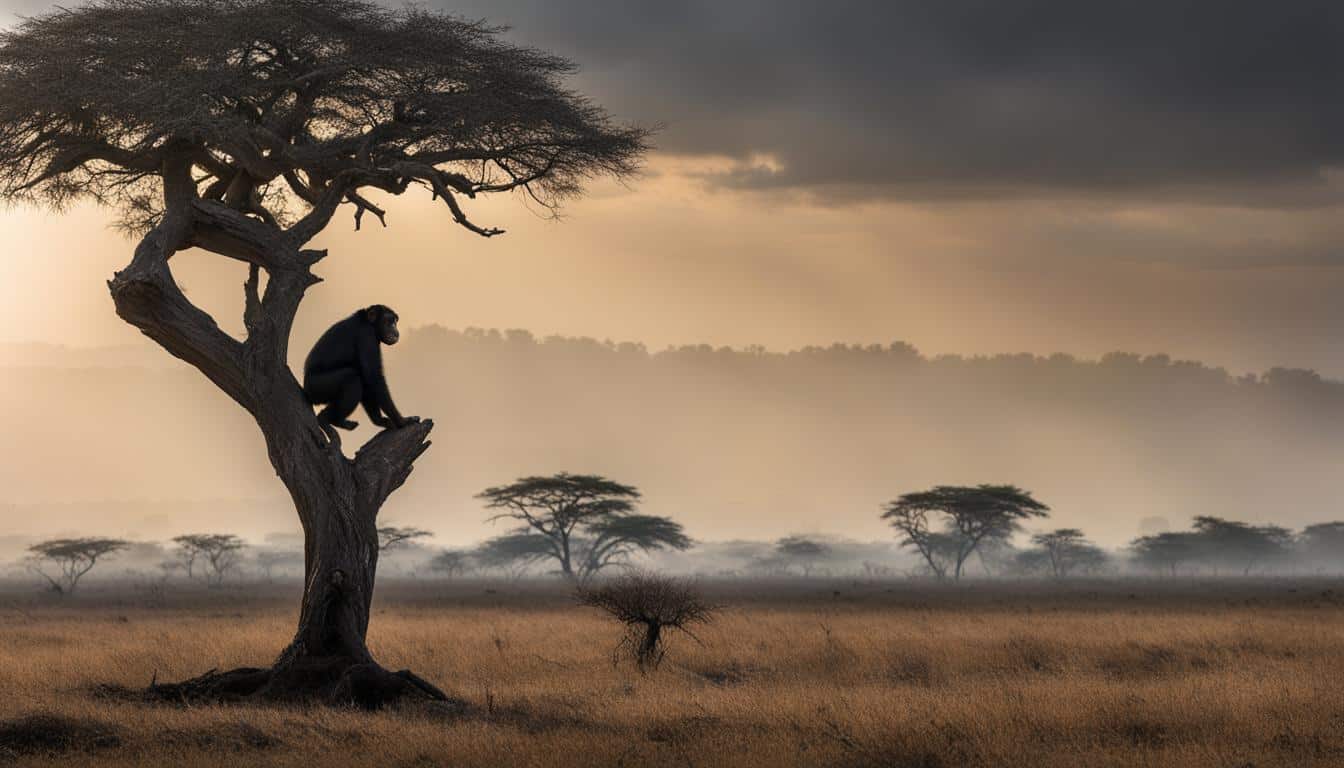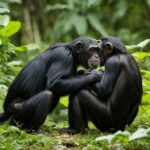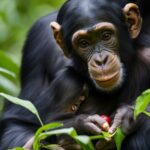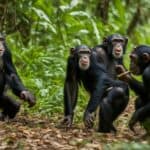Chimpanzees, fascinating and intelligent creatures, are facing a grave threat – habitat loss. As human activities such as habitat destruction and deforestation continue, the survival of these endangered species hangs in the balance. Wildlife conservation and primate conservation efforts are vital to protect the habitat and well-being of these incredible creatures.
In their natural habitats, chimpanzees reside in diverse environments, including rainforests and savanna woodlands. However, with the increasing encroachment of human activities, their homes are being destroyed at an alarming rate. This poses not only a danger to the chimpanzees but also to the delicate balance of the ecosystems they inhabit.
The consequences of habitat loss reach far beyond the chimpanzees themselves. The destruction of rainforests and other habitats leads to the loss of biodiversity, disrupting the intricate web of species interaction and potentially causing ecosystem collapse. Rainforest preservation and protecting biodiversity are essential for the overall health of our planet.
Moreover, human-wildlife conflict arises when the diminishing territories of chimpanzees intersect with human settlements. This conflict not only endangers the lives of chimpanzees but also puts human communities at risk. Finding ways to mitigate this conflict is crucial for the coexistence of humans and chimpanzees.
Conservation efforts play a pivotal role in saving wild chimpanzee populations. By raising awareness about the importance of wildlife conservation, supporting initiatives that combat habitat destruction, and actively participating in primate conservation, we can make a positive impact.
Together, we have the power to protect the habitats of chimpanzees, promote wildlife conservation, and safeguard the future of these incredible creatures. Join the efforts to preserve biodiversity and ensure the survival of chimpanzees for generations to come.
The main threats to chimpanzees
Chimpanzees, our closest living relatives in the animal kingdom, face numerous threats that put their survival at risk. The main factors contributing to the decline of chimpanzee populations are habitat loss, disease, hunting, and the illegal bushmeat trade. These threats have had a particularly devastating impact on these intelligent and endangered creatures.
Habitat loss is one of the most significant challenges for chimpanzees. As human populations expand and agricultural practices intensify, large areas of forests are cleared for farming, logging, and infrastructure development. This destruction of chimpanzee habitats not only disrupts their way of life but also fragments their populations, making them more susceptible to other threats and reducing their chances of survival.
Disease outbreaks, such as the Ebola virus, have had catastrophic effects on chimpanzee populations. These diseases can spread rapidly in close-knit chimpanzee communities, causing mass mortality events and further diminishing their numbers. Additionally, hunting for bushmeat poses a significant threat, with chimpanzees being targeted for their meat, which is considered a delicacy in some regions.
According to the International Union for Conservation of Nature (IUCN), all four subspecies of chimpanzees are currently classified as endangered or critically endangered. Their slow reproductive rate, with females giving birth to a single young every 5-6 years, makes it difficult for their populations to recover from declines caused by these threats.
Chimpanzees in Peril
| Threats | Impact |
|---|---|
| Habitat Loss | Fragmentation, reduced population size, increased vulnerability |
| Disease Outbreaks | Mass mortality events, population decline |
| Hunting (Bushmeat Trade) | Illegal hunting, reduced population size |
| Slow Reproductive Rate | Slow population recovery, vulnerability to declines |
The combination of these threats puts chimpanzees at risk of extinction if immediate and robust conservation efforts are not implemented. Protecting their remaining habitats, combating the illegal bushmeat trade, and addressing disease outbreaks are crucial steps in safeguarding these remarkable creatures and ensuring their continued existence in the wild.
It is vital that we recognize the value of chimpanzees and take action to preserve their habitats and protect them from harm. By doing so, we not only safeguard a species that shares a significant part of our evolutionary history but also contribute to the conservation of biodiversity and the overall health of ecosystems.
The importance of chimpanzees in seed dispersal
Chimpanzees, with their unique role as seed dispersers, play a vital part in the process of forest regeneration and the maintenance of biodiversity. As these intelligent animals consume fruits, the seeds pass through their digestive system, promoting the breakdown of the seed coat and enhancing the chances of germination and seedling growth. By dispersing seeds over long distances, chimpanzees contribute to the gene flow among plant populations and facilitate the colonization of new areas.
A study conducted in the Congo Basin, one of the habitats of chimpanzees, found that large seeds ingested and dispersed by chimps had significantly higher germination rates compared to those that fell directly from trees. This demonstrates the critical role that chimpanzees play in creating favorable conditions for forest regeneration and maintaining healthy ecosystems.
“The seed dispersal activities of chimpanzees support the survival of other plant and animal species in their habitats by enhancing biodiversity and ensuring the availability of resources,” says Dr. Jane Goodall, renowned primatologist and conservationist.
The impact of chimpanzee habitat loss can have far-reaching consequences for seed dispersal and forest regeneration. With the increasing destruction of their habitats due to deforestation, the ability of chimpanzees to disperse seeds is significantly compromised. This has the potential to disrupt the delicate balance of plant species, limit the establishment of new vegetation, and ultimately lead to a decline in biodiversity.
| Importance | Benefits |
|---|---|
| Seed dispersal | Enhanced germination rates |
| Forest regeneration | Facilitates colonization of new areas |
| Biodiversity | Supports the survival of other species |
Protecting chimpanzees and their habitats is crucial for preserving this essential ecological function and ensuring the long-term sustainability of our forests. Efforts to conserve chimpanzee populations and mitigate habitat loss are essential to safeguard the intricate web of life that depends on their seed dispersal activities. By recognizing the importance of chimpanzees as seed dispersers, we can work towards comprehensive conservation strategies that will benefit not only these remarkable animals but also the broader health and resilience of our ecosystems.

The impact of chimpanzee habitat loss on ecosystems and carbon absorption
Chimpanzee habitat loss, particularly through deforestation and environmental degradation, has severe impacts on ecosystems. As chimpanzees require trees for food and shelter, their decline can disrupt the balance of the ecosystem. The destruction of their habitats leads to a loss of biodiversity, as other species reliant on these habitats also suffer. This loss of biodiversity can ultimately lead to ecosystem collapse.
One of the significant consequences of chimpanzee habitat loss is the disruption of carbon absorption. The Congo Basin, where many chimpanzees reside, is the largest carbon sink in the world, surpassing even the Amazon rainforest. The lush forests in this region play a crucial role in absorbing and storing carbon dioxide, helping to mitigate climate change. However, as deforestation and habitat loss continue, the ability of the Congo Basin to absorb carbon decreases, exacerbating the climate crisis.
Protecting chimpanzee habitats is not only essential for the survival of these incredible creatures but also for the health of our planet. By preserving their habitats, we can maintain the delicate balance of ecosystems and ensure the continued absorption of carbon by the forests. Conservation efforts aimed at reducing deforestation and promoting sustainable land use are crucial in mitigating the impact of chimpanzee habitat loss on both ecosystems and carbon absorption.
Table: Comparing carbon absorption in different ecosystems
| Ecosystem | Carbon Absorption |
|---|---|
| Amazon Rainforest | 2.2 billion tons of carbon per year |
| Congo Basin | 600 million tons of carbon per year |
| Boreal Forests | 334 million tons of carbon per year |
| Tropical Savannas | 79 million tons of carbon per year |
The table above highlights the significant role that the Congo Basin plays in carbon absorption. While the Amazon Rainforest is often recognized for its carbon sequestration capabilities, the Congo Basin absorbs a substantial amount of carbon dioxide as well. As chimpanzee habitat loss continues, the ability of the Congo Basin to absorb carbon decreases, further contributing to climate change.
The importance of biodiversity and the current biodiversity crisis
Biodiversity is a fundamental pillar of life on Earth, encompassing the variety of all living organisms, their interrelationships, and the ecosystems they form. However, our planet is currently facing a biodiversity crisis. Extinction rates are accelerating at an alarming rate, threatening the delicate balance of ecosystems and the survival of countless species, including the majestic chimpanzees.
Human activities, such as deforestation, habitat degradation, climate change, and pollution, have significantly contributed to the loss of biodiversity. As a result, species interactions are disrupted, leading to a domino effect of ecological consequences. When species disappear, the intricate web of relationships that sustain ecosystems is disrupted. This can trigger a cascade of negative impacts, culminating in ecosystem collapse and the loss of critical services that nature provides.
“The continued loss of biodiversity jeopardizes our ability to meet the basic needs of present and future generations. It diminishes our food and water security, undermines the stability and resilience of ecosystems, and reduces the chances of discovering new medicines and technologies.”
The consequences of biodiversity loss extend far beyond environmental concerns. They also have profound social and economic implications. Ecosystem services, such as pollination, water filtration, and climate regulation, provided by diverse and healthy ecosystems, are vital for human well-being and the global economy. The loss of these services can lead to increased vulnerability to natural disasters, reduced agricultural productivity, and a higher incidence of disease outbreaks.
It is crucial that we recognize the value of biodiversity and take urgent action to protect and restore it. Efforts to conserve species like the chimpanzees are not only essential for their own survival but for the preservation of healthy ecosystems that support all life on Earth. By promoting sustainable land use practices, fighting against deforestation, and reducing our ecological footprint, we can contribute to safeguarding biodiversity and securing a sustainable future for ourselves and future generations.
Conclusion
Chimpanzee habitat loss is a pressing issue that threatens the survival of these intelligent beings and has far-reaching implications for ecosystems and biodiversity. It is imperative that we prioritize wildlife conservation and make concerted efforts to protect these incredible creatures.
Conservation efforts play a crucial role in safeguarding chimpanzee populations and their habitats. By addressing habitat destruction and promoting wildlife conservation, we can help mitigate the impact of human-wildlife conflict and protect the delicate balance of our ecosystems.
Protecting biodiversity is paramount in our fight against the current biodiversity crisis. The loss of species, including chimpanzees, can lead to the collapse of ecosystems and disrupt species interactions. It is our responsibility to take action now to preserve biodiversity for the well-being of our planet and future generations.
Together, we can make a difference. By supporting conservation efforts, we contribute to the preservation of chimpanzees and the broader goal of protecting biodiversity. Let us continue to champion wildlife conservation, protect their habitats, and ensure a brighter future for these remarkable beings and the health of our planet.
What are the specific effects of habitat loss on wild chimpanzee populations?
Habitat loss and chimpanzee populations are closely linked, as the destruction of their natural environment leads to displacement and decreased resources. This can result in increased conflict between groups, reduced reproductive success, and higher vulnerability to diseases. Overall, habitat loss has a detrimental impact on the survival of wild chimpanzee populations.
FAQ
How is habitat loss impacting wild chimpanzee populations?
Habitat loss, particularly through deforestation and environmental degradation, has severe impacts on chimpanzee populations. As they rely on trees for food and shelter, the decline in their habitat disrupts their survival and increases their vulnerability to extinction.
What are the main threats to chimpanzees?
The main threats to chimpanzees include habitat loss, disease, and hunting, particularly for bushmeat. Their slow reproductive rate makes their populations vulnerable to declines, as it takes a long time to replace individuals that are killed.
What is the importance of chimpanzees in seed dispersal?
Chimpanzees play a crucial role in seed dispersal, particularly for large seeds. As they eat fruits, the seeds pass through their digestive system and are effectively broken down, increasing their chances of germination and seedling growth. Chimpanzees contribute to forest regeneration and gene flow by dispersing seeds over long distances, supporting biodiversity and the survival of other plant and animal species.
How does chimpanzee habitat loss impact ecosystems and carbon absorption?
Chimpanzee habitat loss, particularly through deforestation and environmental degradation, has severe impacts on ecosystems. As chimpanzees require trees for food and shelter, their decline disrupts the balance of the ecosystem. Additionally, the Congo Basin, where many chimpanzees reside, is the largest carbon sink in the world, absorbing more carbon than the Amazon. If chimpanzees and their habitats are pushed to the brink of extinction, it not only threatens their survival but also harms carbon absorption and the overall health of the planet’s ecosystems.
What is the importance of biodiversity and the current biodiversity crisis?
Biodiversity is essential for the functioning of ecosystems and the survival of species. The current biodiversity crisis, with extinction rates accelerating, poses a significant threat to ecosystems. The loss of species, including chimpanzees, can have a cascading effect on ecosystems, leading to ecosystem collapse and loss of species interaction. It is crucial to protect and conserve biodiversity for the well-being of the planet and ourselves.
How can we contribute to the conservation of chimpanzees and biodiversity?
Conservation efforts are critical to protect chimpanzee populations and their habitats. By addressing habitat destruction, promoting wildlife conservation, and supporting efforts to combat human-wildlife conflict, we can contribute to the preservation of chimpanzees and the broader goal of protecting biodiversity. Together, we can make a difference for the future of these incredible creatures and the health of our planet.







